Paestum, a UNESCO World Heritage site in southern Italy, beckons visitors with its remarkably preserved ancient Greek ruins. This archaeological gem boasts an impressive trio of Doric temples dating back to between 550 and 450 BCE, showcasing the city’s rich cultural heritage and engineering prowess. Knowledgeable guides and well-maintained paths offer an immersive experience, allowing travelers to explore these historical treasures. Whether you’re an architecture enthusiast or simply captivated by the allure of the ancient world, Paestum promises to unveil fascinating insights that may just leave you wondering what other secrets this remarkable site holds.
Key Points
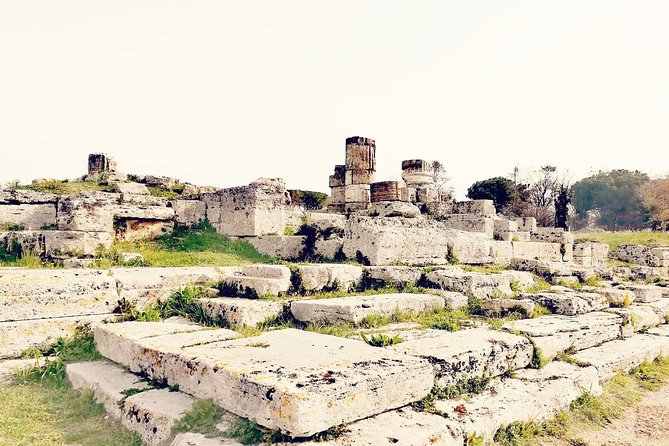
- Paestum is a UNESCO World Heritage site known for its well-preserved ancient Greek ruins, including three Doric temples dating back to the 6th-5th century BCE.
- The architectural highlights of Paestum include the Temple of Hera, Temple of Athena, and Temple of Poseidon, showcasing the city’s rich cultural heritage.
- Paestum’s sanctuaries and temples provide insight into the spiritual practices and rituals of ancient Greek civilizations that once inhabited the area.
- The archaeological remains in Paestum, such as the agora and city walls, reveal the daily life, commerce, and strategic importance of the ancient city.
- The Paestum site offers a well-maintained and informative visitor experience, with guided tours, audio guides, and various amenities to enhance the exploration of the ancient ruins.
Exploring the Ancient City

Visitors to the Paestum UNESCO World Heritage site embark on a captivating journey through the ancient Greek city’s well-preserved ruins.
Wandering the vast archaeological park, travelers are transported back in time, marveling at the stunning Doric temples that stand as a testament to the city’s illustrious past.
From the majestic Temple of Poseidon to the intricately carved reliefs, each corner of Paestum reveals a new layer of history.
Knowledgeable guides provide insights, bringing the site’s rich heritage to life.
Explore the ancient streets, amphitheater, and necropolis, uncovering the everyday lives of Paestum’s former inhabitants.
This immersive experience offers a profound connection to the classical world, leaving visitors with a deeper appreciation for the enduring legacy of ancient Greece.
You can also read our reviews of more historical tours in Campania
Architectural Marvels of Paestum
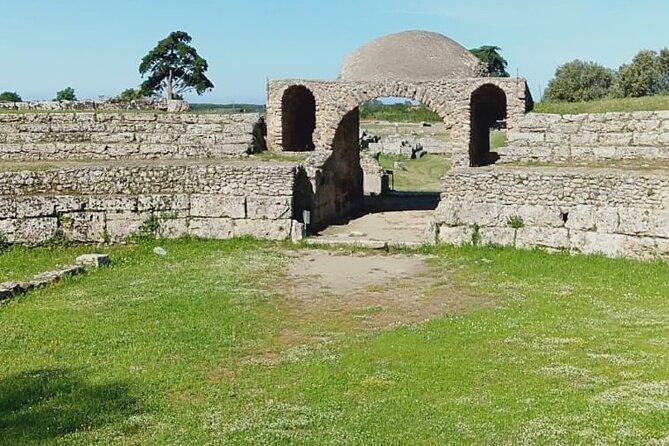
The ancient city of Paestum boasts a remarkable collection of Doric temples that stand as architectural masterpieces of the classical world.
These temples, built between 550 and 450 BCE, showcase the iconic Greek architectural style with its distinctive columns, pediments, and intricate sculptural details.
Highlights include:
- The Temple of Hera, a well-preserved example of the Doric order with its imposing columns and impressive scale.
- The Temple of Athena, renowned for its graceful proportions and elegant decorative elements.
- The Temple of Poseidon, an exceptionally well-preserved structure that exemplifies the refinement and precision of ancient Greek temple architecture.
- The Basilica, a unique structure that blends Doric and Ionic architectural elements, providing a fascinating glimpse into the evolution of classical design.
Temples and Sanctuaries

Among the architectural marvels of Paestum, the temples and sanctuaries stand out as the crown jewels. The ancient Greeks built several grand temples, including the Temple of Hera, the Temple of Athena, and the Temple of Poseidon.
These structures showcase the region’s rich cultural heritage and impressive engineering feats. Visitors can explore the imposing columns, intricate carvings, and well-preserved ruins that transport them to the city’s illustrious past.
Beyond the temples, the site also contains several sanctuaries, where religious rituals and ceremonies were once performed. These sacred spaces offer a glimpse into the spiritual practices of the ancient Paestum community.
Exploring the temples and sanctuaries is a must for anyone seeking to understand the captivating history of this UNESCO World Heritage site.
Historical Significance
Steeped in a rich and storied past, Paestum’s historical significance extends far beyond its well-preserved Greek temples.
Once a thriving ancient Greek city, Paestum has witnessed the rise and fall of empires, from the Lucanians to the Romans. Its archaeological treasures offer a captivating glimpse into the daily lives and cultural practices of these ancient civilizations.
Visitors can explore:
- The remains of the agora, or marketplace, where commerce and social activities once bustled
- The well-preserved Sanctuary of Hera, a testament to the religious beliefs and rituals of the ancient Greeks
- The impressive city walls, a testament to Paestum’s strategic importance and defensive capabilities
- The remarkable collection of Greek and Roman artifacts housed in the on-site museum.
Paestum’s Vibrant Culture
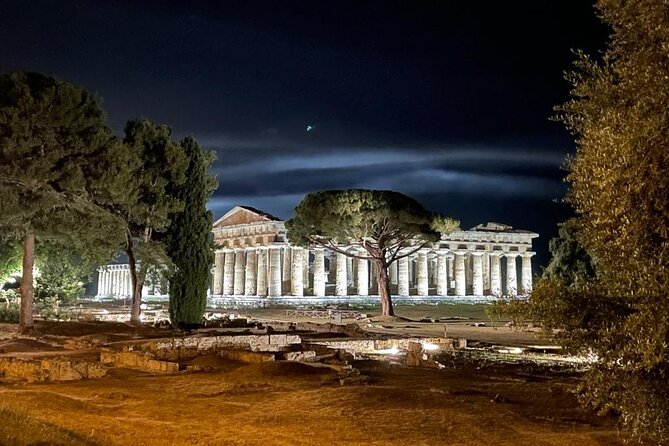
Though long overshadowed by its ancient temples, Paestum’s vibrant cultural heritage is equally deserving of attention.
Today, the city’s modern inhabitants proudly preserve traditions passed down through generations. Local artisans craft intricate ceramics, weave distinctive textiles, and produce award-winning culinary delights.
Visitors can enjoy this living legacy by exploring bustling open-air markets, attending lively festivals, and participating in hands-on workshops.
Whether strolling cobblestone streets or dining alfresco, travelers discover Paestum’s enduring spirit – a harmonious blend of ancient roots and contemporary vitality.
From its dynamic arts scene to its gastronomic riches, this UNESCO World Heritage site offers a multifaceted cultural experience that enlivens the senses and nourishes the soul.
Visitors to Paestum’s UNESCO World Heritage site can explore an impressive array of ancient Greek and Roman ruins. The well-preserved archaeological park offers a unique opportunity to step back in time.
Navigating the site is seamless, with:
- Clearly marked paths and signage guiding visitors through the ancient temples, amphitheaters, and necropolis.
- Audio guides available to provide historical context and insights into the site’s rich heritage.
- Knowledgeable on-site staff ready to answer questions and offer recommendations.
- Shaded areas and benches scattered throughout, allowing visitors to rest and take in the surroundings.
The archaeological site is a testament to Paestum’s enduring legacy, inviting travelers to enjoy the city’s captivating past.
Visitor Amenities and Facilities
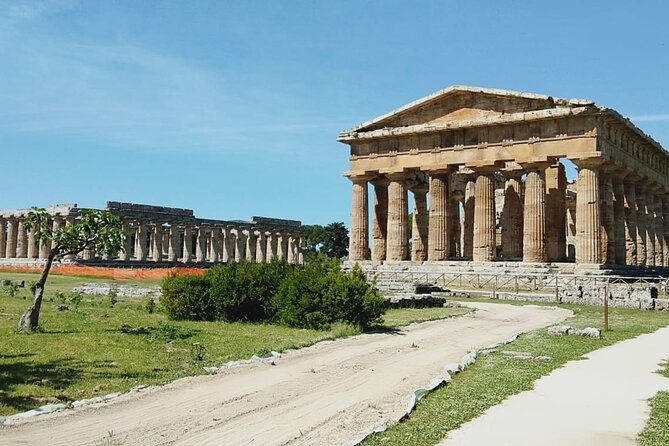
The archaeological park of Paestum offers a range of visitor amenities and facilities to enhance the overall experience.
Visitors can find a ticketing office, restrooms, and drinking water stations strategically placed throughout the site. A well-stocked gift shop provides visitors with the opportunity to purchase souvenirs and educational materials.
There are also picnic areas where visitors can enjoy a meal and take a break from exploring the ancient ruins. The park’s infrastructure is designed to cater to the needs of both locals and international travelers, ensuring a comfortable and enjoyable visit.
With these convenient facilities, travelers can make the most of their time at the UNESCO World Heritage site.
Planning Your Visit
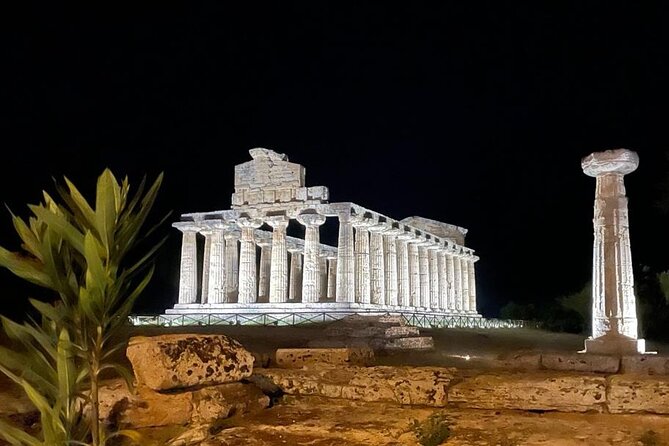
Planning a visit to the Paestum UNESCO World Heritage site requires some advance preparation. Visitors can purchase tickets in advance from the Archaeological Park of Paestum to avoid long queues.
The experience starts at the meeting point in Pisciotta and ends back at the same location. The tour is conducted in an air-conditioned vehicle, though the site itself may not be wheelchair accessible.
Visitors should note the following:
- The tour begins at 3:00 PM and lasts for an unspecified duration.
- Children can participate, but infants must sit on laps.
- Service animals are allowed, but strollers are accessible.
- Free cancellation is available up to 24 hours before the start of the experience.
Frequently Asked Questions
Is the Site Open Year-Round?
The site is open year-round, though visitors should note that hours and accessibility may vary seasonally. Checking the official website or contacting the provider is recommended to confirm the current status before visiting.
Can I Purchase Tickets On-Site or Online?
Tickets can be purchased at the Ticket Redemption Point, the Archaeological Park of Paestum. Online booking is also available, providing flexibility to reserve now and pay later.
How Long Does the Guided Tour Typically Last?
The guided tour typically lasts around 2-3 hours. Visitors will explore the ancient Greek ruins, temples, and museum at their own pace with the expert guidance of a knowledgeable local tour guide.
Are There Any Special Events or Festivals Held at Paestum?
The Archaeological Park of Paestum hosts several festivals and events throughout the year, including the Paestum Jazz Festival in summer and the annual Salerno Campania Food Festival. These cultural events showcase the region’s rich history and traditions.
What Languages Are Available for the Guided Tours?
The guided tours at Paestum are available in multiple languages, including English, Italian, and other major European languages. Travelers should check with the provider for specific language options when booking their tour.
The Sum Up
Paestum’s ancient Greek ruins offer visitors a remarkable glimpse into the city’s rich cultural heritage. With its well-preserved Doric temples and knowledgeable guides, the UNESCO World Heritage site provides an immersive experience of ancient Greek architecture and legacy. Visitors can explore the archaeological site, take advantage of the visitor amenities, and plan their visit to fully appreciate Paestum’s historical significance and vibrant culture.
More Historical Tours in Campania
More Tour Reviews in Campania
- Calabrian Alpacas Sunset Beach Experiences Pizzo VV AlpacSelfies
- Lezione di Cucina : Pasta Fresca
- Vesuvio Gran cono + Wine Tasting & Lunch + Transfer from Naples
- Lifestyle of The Ancient Rich: Domus & Villa in Pompeii, Oplontis and Boscoreale
- Cilento Wine: Tour & Tasting Experience
- Transfer from Naples to Sorrento or vice versa
Not for you? Here's more nearby things to do in Campania we have reviewed
- Lezione di Cucina : Pasta Fresca
- Vesuvio Gran cono + Wine Tasting & Lunch + Transfer from Naples
- Lifestyle of The Ancient Rich: Domus & Villa in Pompeii, Oplontis and Boscoreale
- Cilento Wine: Tour & Tasting Experience
- Transfer from Naples to Sorrento or vice versa
- Grotte Di Capo Palinuro
- Panoramic tour under the stars with tasting on board
- “Classic” Boat Trip to Capo Palinuro
- Cilento, Trentinara, Via Roma, Tredaniele Shared Wine Tasting
- Visit The Royal Palace and Cooking Class Experience
- Naples Private Departure Transfer from Naples city centre to airport
- Full-Day Pompeii And Mt.Vesuvius Hike from Naples
